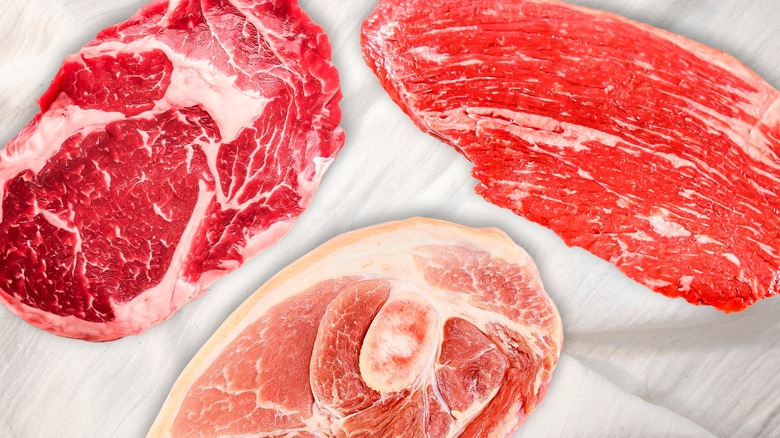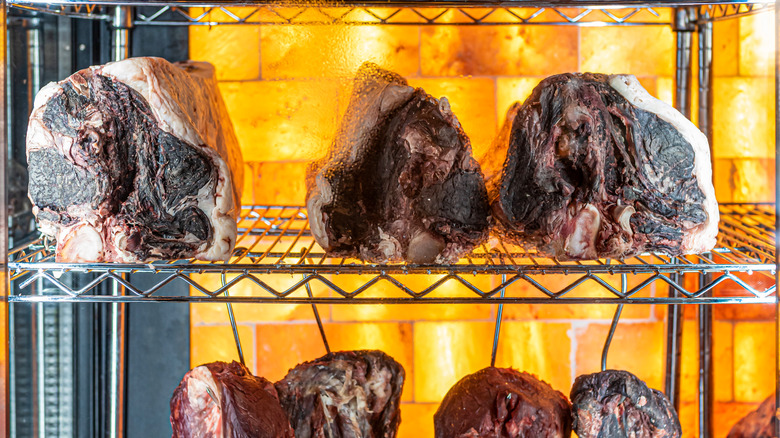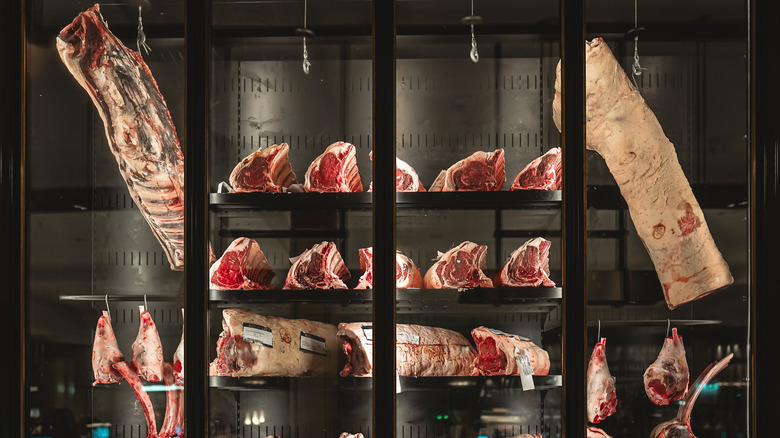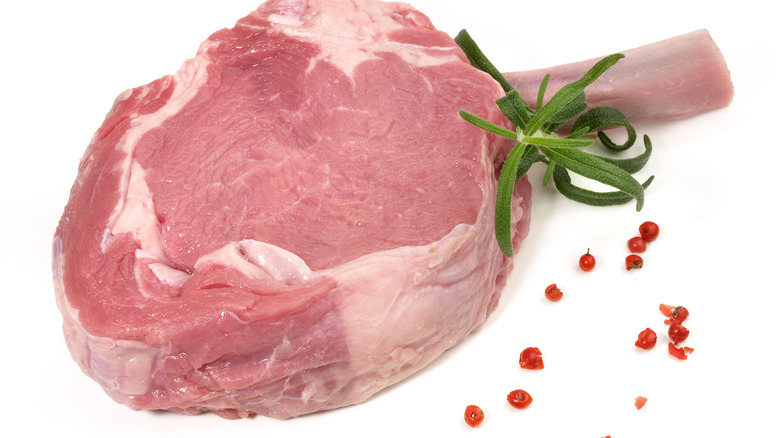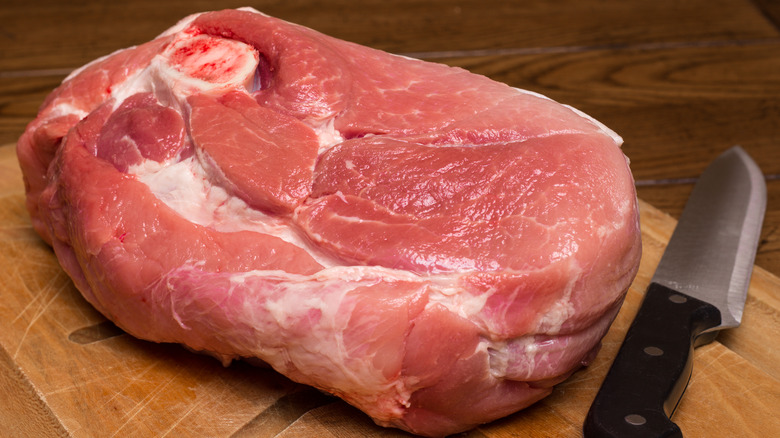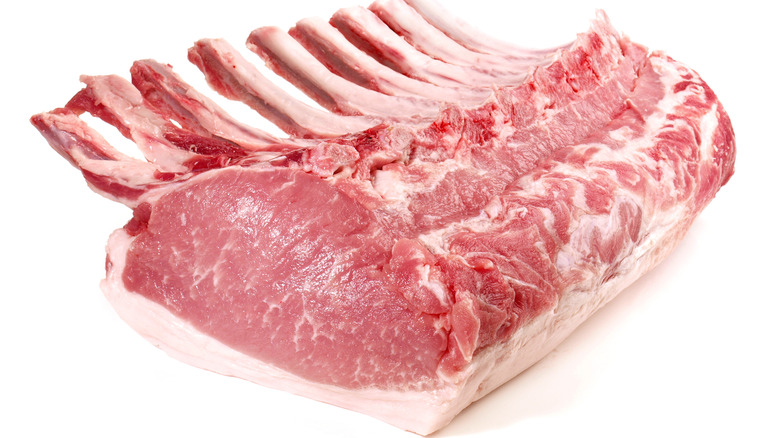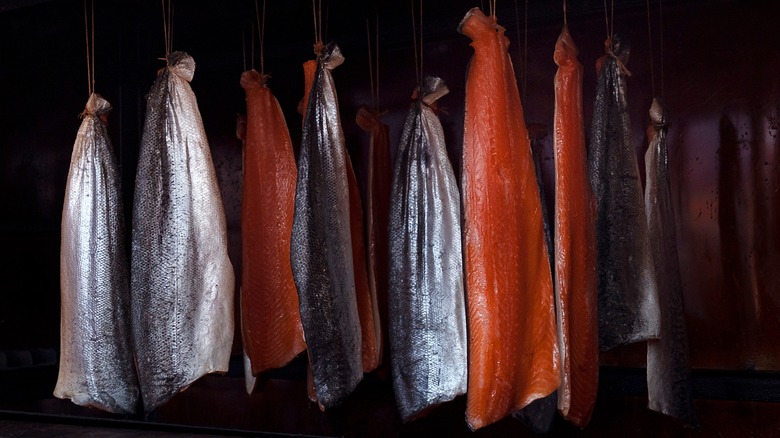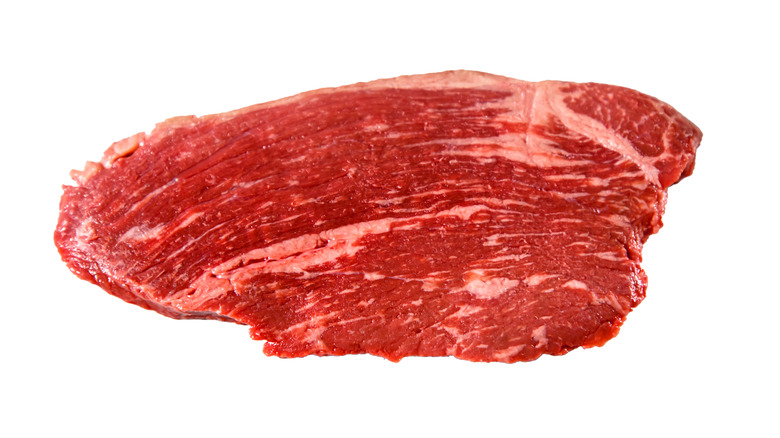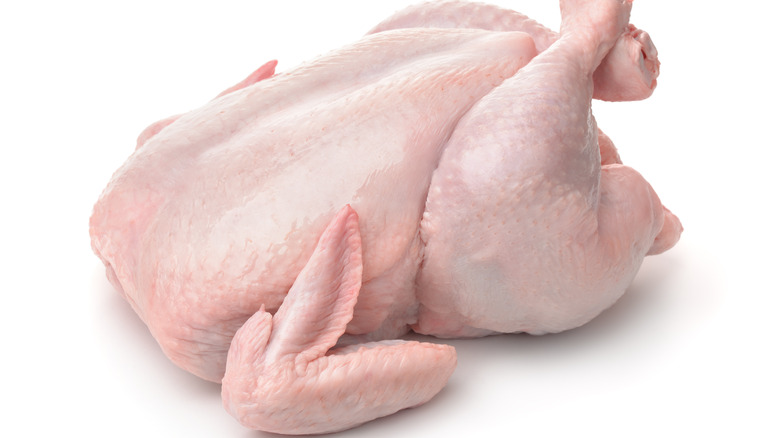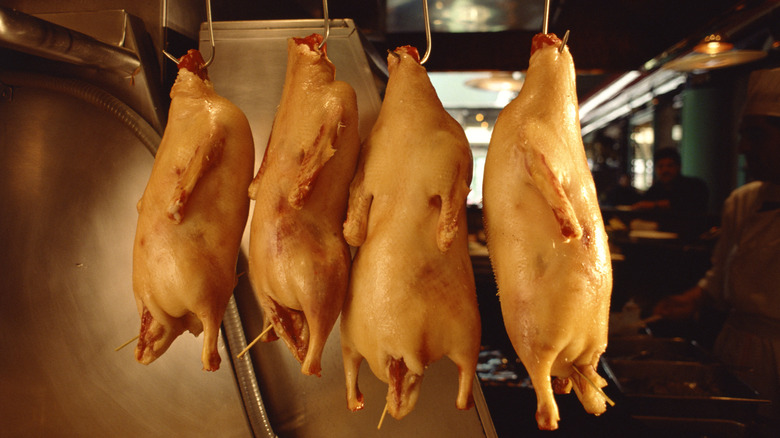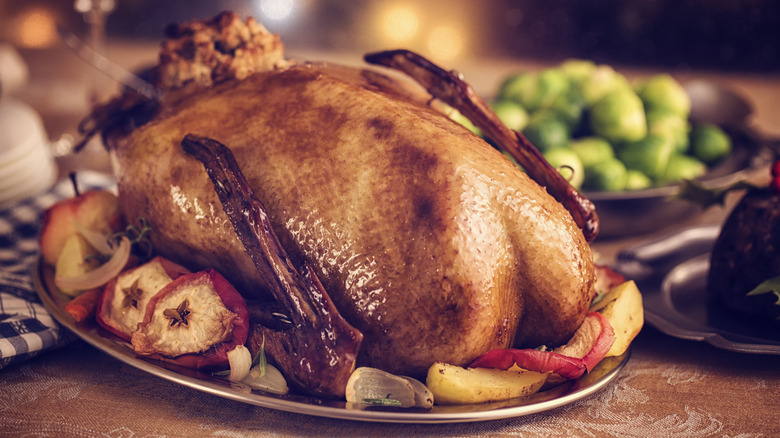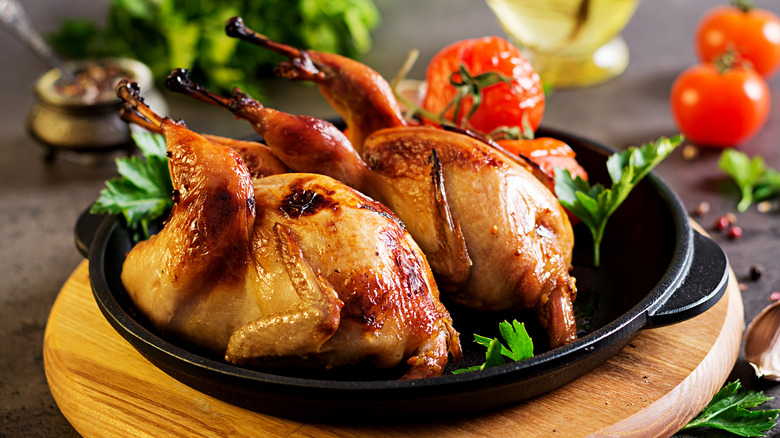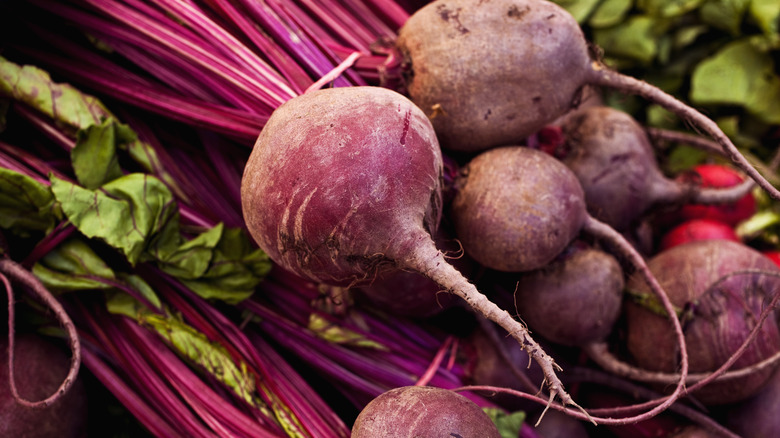The 9 Best Cuts Of Meat To Dry Age
There's a reason steaks taste different at high-end steakhouses. Dry aging is a common method of maintaining larger cuts of meat in a controlled environment to concentrate the flavors and tenderize the meat. I used to serve a particular heritage breed of cattle in a restaurant I owned that taught me about dry aging. As my restaurant was one of the only commercial outlets, there weren't mechanisms in place to purchase the meat from a wholesaler; I had to buy the heads of cattle directly from the rancher and take them to a processor, where I'd let them hang for 28 days before going back to collect them. The carcasses would come through my back door looking beat up, dried out, and sometimes growing mold. They were perfect. By hanging them for four weeks in a controlled environment, they'd lost moisture, the beef flavor concentrated, the meat tenderized, and in the instance of mold, they'd gained a prosciutto-like note to their overall taste.
To learn more about dry aging and what meats work well in the process, we spoke to chef Ian Boden, owner of The Shack and the soon-to-open Maude & the Bear in Staunton, Virginia, and culinary partner of Washington, D.C.'s Tabard Inn. We discussed the best meats, best aging practices, and the common mistakes people make when dry aging at home.
One of the biggest mistakes people make is drying their meat too quickly. An exterior crust, called a pellicle, forms on the meat during aging. When drying too quickly, that pellicle hardens and doesn't allow the free flow of water to the meat's exterior, causing the meat to rot from the inside. There are also many vectors for foodborne illness, so cleaning, sanitation, and proper handling and storage practices are crucial to success.
What is dry aging?
On the outside, dry aging looks like setting meat on a shelf to spoil. What's really happening is the meat (or vegetable) undergoes a controlled evaporative process.
In most cases, when you leave a piece of meat in the refrigerator for a couple of weeks, you expect it to go bad. One of the biggest reasons for that is when allowed to sit in a container, any water that escapes the meat pools at the bottom, and that, combined with the moisture in the meat, is a channel for bacterial growth inside the meat. By not allowing the water to pool and controlling the humidity and temperature during the process, chefs manipulate the evaporation rate, which concentrates the meat's flavor while tenderizing it. Boden likes to age meat at the highest temperature allowable by the United States Department of Agriculture (USDA), 40 F, at 80% humidity.
Typically, meat dry ages two to four weeks but can age as long as 120 days. As the meat ages, it commonly develops a white mold on the exterior that contributes tenderness and flavor, similar to that found on dried sausages or cured hams like prosciutto. At about 14 days, the meat shows signs of tenderizing, and it starts developing "funky" flavors from the mold development between 21 and 28 days. After aging for the desired amount of time, the dried and moldy exterior gets removed, and the tender, flavorful interior meat heads for the stove, grill, or oven.
How to dry age
In addition to a refrigerator, you need a means to keep the meat out of water, control humidity, and ensure airflow. You can meet these requirements with a wire cooling rack on a baking sheet, a salt block, and a fan. The cooling rack keeps the meat out of water. Humidity below 85% is key, so if your fridge measures anywhere above 80%, a salt block will suck some of the ambient moisture and lower the humidity. A small clip-on fan provides airflow throughout the process. This is fine if you're just trying it out, but Boden has thoughts.
"In your home fridge, you have so much bacteria and ambient molds floating around that you know you run the risk of spoilage," he says. "Honestly, you can buy a small home dry aging chamber for a couple hundred bucks these days. So if it's something that a home cook is super-interested in, I think it's worth a small investment [for] a more controlled environment, especially for a longer age. It's so not worth wasting the product."
Once you have your environment handled, you simply put your meat inside and wait. Some people add starters like koji or blue cheese, to which Boden says, "All it does is make things taste like koji, and people have gone a little over the top with it. I want my beef to taste like beef. That's why I'm aging it, right?"
Ribeye/veal rack
Size matters when dry aging because your meat will lose water via evaporation. It's safe to assume you'll lose 15-25% of the original weight from moisture loss. "I think that if you're putting anything less than four pounds in your chamber, you're wasting your money," Boden says. Considering that you could end up with three pounds of finished meat at four pounds of original weight, he's got a point.
Bone-in ribeye is an excellent cut for dry aging. A quick Google image search for "dry-aged beef" returns an astonishing percentage of ribeye photos that back his assertion. Boden looks for two things for dry-aging beef: Bones that add umami as the meat ages and a healthy fat cap that protects the meat from losing moisture too quickly. A whole, bone-in rib sub-primal ticks those boxes quite well. His location in Virginia's Shenandoah Valley gives him access to hyper-farm fresh meats, including beef ribeyes that smell "super grassy, like cream," after aging.
That access includes other ingredients for aging. "Right now, I've got two racks of veal [in the aging chamber], which we've never done before, but I'm excited to try," he says. It's a natural progression, considering a veal rack and a rib sub-primal are the same cuts from cattle of different ages. Veal is younger and, therefore, has less fat and marbling and hasn't developed the deep red coloring that beef typically has yet, although it has a well-developed fat cap, as suggested above.
Pork shoulder
A bone-in pork shoulder fits the bill of bone and fat cap requirements Boden looks for. While dry aging a pork shoulder increases the density and flavor for cooking, Boden likes to age shoulders for a different purpose. "We do a lot of sausages and stuff like that at the restaurant, so we'll get a whole shoulder, and I'll throw it in the dry ager for a month [before processing it into sausage]," he says.
You're certainly not limited to using an aged pork shoulder for sausage. Slow roasting or smoking are great options for the intensified flavor and texture dry aging instills, but quick-cooking techniques shouldn't be off the table. The denser meat is also an excellent candidate for cutting into steaks. Applying your favorite pork-centric dry rub and quickly searing a pork shoulder steak straight from the butcher in its natural state is a perfect way to prepare a pork steak. But the funkiness and tenderness added by dry aging take the experience up several levels. The reduced moisture content helps give the pork steaks a beautiful sear, and the rub adds to the crispness of the exterior.
Pork loin
If veal and beef rib sections are prime candidates for dry aging, why not pork loin? The physical structure is essentially the same — rib bones attached to an "eye" as in ribeye, and they all have a nice cap of fat covering them. "The loins, they dry just beautifully," Boden says. Restating his reasoning for his drying technique, he continues, "I like bone-in. In my opinion, it's pretty necessary as it helps with loss, right? Because it's drying, you're getting the same surface area and permeation, but you're cutting off the bones anyway, so I feel like you have a little bit more stability, and you can age it for a little bit longer with a little less loss."
Because a pork loin has less marbling and higher water content than a shoulder and significantly less than a beef rib sub-primal, limiting the aging to 10-14 days is a safe bet for aging to minimize chances of spoilage or meat loss. After trimming, you can roast the loin whole on the bone or cut it into individual chops and pan-sear, sous vide, or grill them. The reduced water content from aging helps develop an incredible sear or Maillard crust when cooked whole or as chops.
Whole fish or fillets
Dry aging fish is a relatively new trend in the U.S. based on a centuries-old Japanese sushi technique. Boden has adopted the method and put it to use in his restaurant. "There are people that are much more versed in that that are publishing books currently about dry aging fish," he quickly adds as a disclaimer before describing some of the challenges. "Fish is harder only because the fats are a lot more volatile and can go off a lot easier. Water is your enemy, so make sure the cavity is super dry and there's no blood left in the cavity. Make sure you know the gallbladder's out, and the heart's out all those bits and pieces. Those go rancid and will aromatize the rest of the meat, turning it all into trash."
With that kind of risk, why age fish at all? Like meat, aging fish increases the umami flavors by removing the water content. The benefits of drying-aging fish also reverse the effects of rigor mortis, relaxing tendons and rendering fats, glycogens, and proteins into more tender flesh. Many restaurants specializing in this will hang whole fish to age, but this may provide space limitations for home users. In that case, aging fillets on an elevated wire rack works almost as well.
Coulotte
You may be getting the idea that Boden doesn't work in typical lanes, ingredient or technique-wise. When asked what his favorite meats to dry age are, beef isn't high on the list. "I'd say beef only because the beef is just kind of expected. I think kind of everybody knows what dry-aged beef tastes like now." While he'll work in the ribeye color palate, he's slightly more excited about the coulottes he has in the aging chamber.
The coulotte comes from the sirloin cap, which sits behind the short loin, above the flank, and in front of the round when looking at beef anatomy. This triangular cut is extremely well-marbled, with a respectable fat cap. Although a coulotte isn't a bone-in cut, the fat cap and marbling make it a good candidate for aging. After aging and trimming, it comes time to cook the coulotte. If cooking the coulotte as a whole roast, slow cooking on a grill or in the oven is the best means of bringing out the best flavor and juiciness, rendering the fat cap and activating the intra-muscular marbling. You can also cut the coulotte into steaks, which benefit from a quick sear followed by indirect heat to finish it. Because of the density of its muscle fibers, we don't recommend cooking a coulotte roast beyond medium rare.
Chicken
If you could see someone getting excited about a topic over the phone, that would be the experience with Boden when discussing dry-aging chicken. With his easy access to fresh ingredients, he wants to bring out the best of his locally-raised chickens. "A farmer we work with does two runs a year for us. We get them all in, and they go right into the dry ager for four to six days, depending on their size, and that's kind of been the sweet spot for us," he says.
Dry-aging chicken accomplishes many of the same goals as aging beef or pork, with a bonus. "You get you get a more poultry flavor," Boden says, "But the skin just crisps beautifully, so as soon as you baste, it almost crisps like a crackling, you know what I mean?" (For those unfamiliar with the Southern term, think pork rind or chicharrone.)
While Boden has a dedicated dry-aging cabinet, he explains that the best way to dry-age chicken at home is to spatchcock it to increase the surface area, then place it on a wire rack over a baking sheet in your refrigerator. The ideal time varies from three days to Boden's recommended four to six days.
Duck
Duck is a lean, dark meat with a fantastic fat cap from the skin. That fits the profile of good meat for dry aging. "One of our waiters raises ducks for us, and one of the things about that is the tenderness, so you have that breakdown [in aging]," Boden says. Farm fresh is the best choice for ducks, according to Boden, but not everyone has that opportunity, and aging can help improve the flavor and texture of commodity ducks. "You know, when you buy duck industrially, it ends up being flabby. The flesh isn't firm, and the texture is not quite as nice," he says. "With the local ducks, obviously, all the things are better, but with aging, you get a little bit more breakdown, and with aging industrial ducks, you don't have tougher bits now. They tend to be much more tender."
Dry aging duck isn't a new technique. It's a centuries-old common first step in preparing Peking Duck. For home aging, bone-in is always best, and one could spatchcock the duck for better surface area and more uniform drying. But if space is an issue, aging the boneless breasts and bone-in legs is an option. You can then pan-roast the breasts and level up your duck confit with the dry-aged legs.
Goose
While U.S. consumers regard geese as special-occasion meat more than ducks or chickens, they're still great candidates for dry aging, thanks to their fatty skin and pockets of fat near the surface. The idea behind dry aging poultry isn't to extract water from the meat but to remove it from the skin and the layer between the skin and the flesh. However, flavor concentration and tenderization of the meat are part of the benefit. Geese are subject to the same aging process and cycle as chickens, three to six days.
The big issue with roasting poultry or fowl is trying to cook a piece of meat of varying thicknesses whose parts finish cooking at different temperatures while trying to perfect a crispy skin. After the aging process, thanks to the decreased moisture content, the skin will crisp much faster, so you won't need to cook it as long as a fresh goose to render the fat and crisp it. To tackle a roast goose for even browning, you may find that removing the breasts halfway through cooking and pan-searing them while the legs cook is still a good idea, but there's a high probability additional browning isn't a top requirement.
Small poultry
Boden's preference for dry-aging poultry doesn't stop at large birds. He's also got a penchant for small fowl and game birds. Poussin, also called a spring chicken, is a young chicken with all white meat, even the legs. Smaller surface area and density call for a shorter age time, but the poussin still benefits from a few days of aging.
Boden's farm partners also raise Guinea fowl, which see a trip through the dry-ager for a few days. Guinea hens have red meat and are a little smaller and leaner than chickens, so they see a shorter aging period than chickens. After aging, you can butcher the fowl for pan roasting, or it's excellent roasted whole, such as in this rosemary-brined guinea hen recipe.
Quail, although tiny by comparison with the other poultry and game birds, are quick-aging and delicious after a brief time drying. By concentrating the flavor via evaporation, one would expect a more quail-y flavor. But instead, the aging brings about a delicacy in the meat one wouldn't normally expect or encounter.
What about vegetarians?
A question arose after covering a gamut of meat, fish, and especially poultry as the best picks for dry aging. If the concept of aging beef can expand into these other areas, does it have to stop at animal protein-based foods? Could the same principles apply to vegetables and fruits?
Vegetables have a significantly different structure and composition than animal proteins, but some research showed that with some additional manipulation, dry-aged beets became a reality. According to their creators, the concentration of umami flavors makes the dried beets a starting point for a vegetarian steak tartare or carpaccio. Chef Dominique Crenn developed a carrot jerky several years ago that the team hoped to expand to similar vegetables, like beets and parsnips. If a carrot recipe could move forward to beets due to a similar composition and structure, it might be both possible and plausible to reverse dry-aged beet techniques to carrots.
